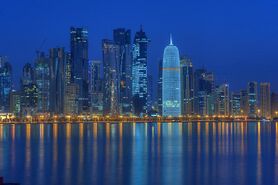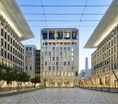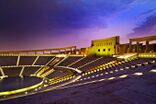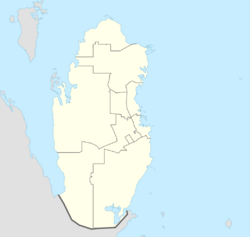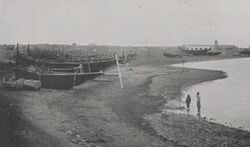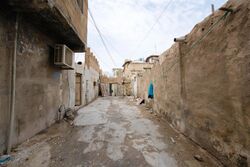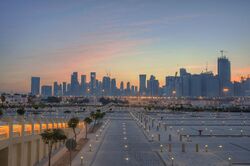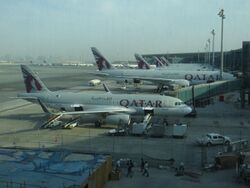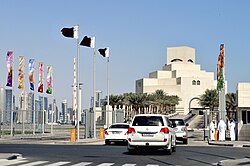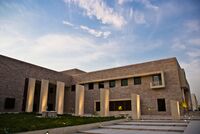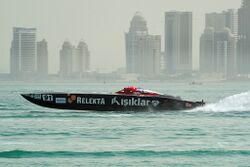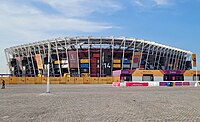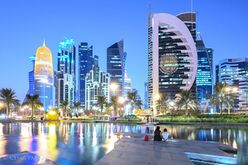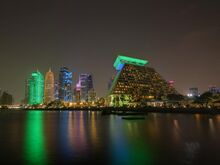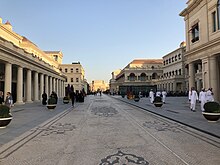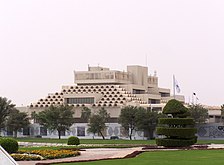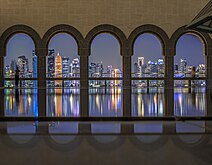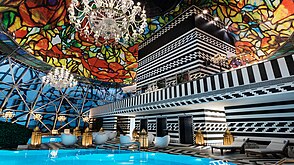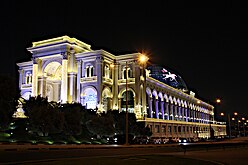Doha
Topic: Place
 From HandWiki - Reading time: 47 min
From HandWiki - Reading time: 47 min
Doha الدوحة | |
|---|---|
Capital city | |
Counter-Clockwise from top: the skyline of Doha at night; modern buildings in West Bay district; Amiri Diwan, which serves as the office of the Emir of Qatar; Souq Waqif; National Museum of Qatar; Musheireb downtown Doha; and Katara Cultural Village | |
| Coordinates: [ ⚑ ] : 25°17′12″N 51°32′0″E / 25.28667°N 51.533333°E | |
| Country | Qatar |
| Municipality | Doha |
| Established | 1825 |
| Area | |
| • City proper | 132 km2 (51 sq mi) |
| Population (2015)[1] | |
| • City proper | 956,457 |
| • Density | 7,200/km2 (19,000/sq mi) |
| Time zone | UTC+3 (AST) |
| Website | visitqatar.com/doha |
Doha (Arabic: الدوحة [adˈduħa] or ad-Dūḥa) is the capital city and main financial hub of Qatar. Located on the Persian Gulf coast in the east of the country, north of Al Wakrah and south of Al Khor, it is home to most of the country's population.[2] It is also Qatar's fastest growing city, with over 80% of the nation's population living in Doha or its surrounding suburbs.[1]
Doha was founded in the 1820s as an offshoot of Al Bidda. It was officially declared as the country's capital in 1971, when Qatar gained independence from being a British protectorate.[3] As the commercial capital of Qatar and one of the emergent financial centers in the Middle East, Doha is considered a beta-level global city by the Globalization and World Cities Research Network. Doha accommodates Education City, an area devoted to research and education, and Hamad Medical City, an administrative area of medical care. It also includes Doha Sports City, or Aspire Zone, an international sports destination that includes Khalifa International Stadium, Hamad Aquatic Centre; and the Aspire Dome.
The city was host to the first ministerial-level meeting of the Doha Development Round of World Trade Organization negotiations. It was also selected as host city of a number of sporting events, including the 2006 Asian Games, the 2011 Pan Arab Games, the 2019 World Beach Games, the FINA World Aquatics Championships, the FIVB Volleyball Club World Championship, the WTA Finals and most of the games at the 2011 AFC Asian Cup. In December 2011, the World Petroleum Council held the 20th World Petroleum Conference in Doha.[4] Additionally, the city hosted the 2012 UNFCCC Climate Negotiations and the 2022 FIFA World Cup.[5] The city will host the 2027 FIBA Basketball World Cup.
The city also hosted the 140th Inter-Parliamentary Union Assembly in April 2019 and hosted the 18th yearly session of the United Nations Framework Convention on Climate Change in 2012. Doha has been named as the second safest city in the world in the Numbeo Crime Index by City 2021.[6] The index, which tracks safety in 431 cities, reaffirms the country's outstanding level of safety and security, while strengthening Doha's reputation as a desirable city where business and leisure travellers can enjoy award-winning hospitality, business-friendly environments and service excellence.[7] Doha's hosting of the FIFA world cup is considered a major Qatari soft power success.[8][9][10][11]
Etymology
According to the Ministry of Municipality and Environment of Doha, the name "Doha" originated from the Arabic term dohat, meaning "roundness"—a reference to the rounded bays surrounding the area's coastline.[12]
History
Establishment of Al Bidda
The city of Doha was formed seceding from another local settlement known as Al Bidda. The earliest documented mention of Al Bidda was made in 1681 by the Carmelite Convent, in an account which chronicles several settlements in Qatar. In the record, the ruler and a fort in the confines of Al Bidda are alluded to.[13][14] Carsten Niebuhr, a German explorer who visited the Arabian Peninsula, created one of the first maps to depict the settlement in 1765 in which he labelled it as 'Guttur'.[13][15]
David Seaton, a British political resident in Muscat, wrote the first English record of Al Bidda in 1801. He refers to the town as 'Bedih' and describes the geography and defensive structures in the area.[16] He stated that the town had recently been settled by the Sudan tribe (singular Al-Suwaidi), whom he considered to be pirates. Seaton attempted to bombard the town with his warship, but returned to Muscat upon finding that the waters were too shallow to position his warship within striking distance.[17][18]
In 1820, British surveyor R. H. Colebrook, who visited Al Bidda, remarked on the recent depopulation of the town. He wrote:[17][19]
Guttur – Or Ul Budee [Al‐Bidda], once a considerable town, is protected by two square Ghurries [forts] near the seashore; but containing no freshwater they are incapable of defense except against sudden incursions of Bedouins, another Ghurry is situated two miles inland and has fresh water with it. This could contain two hundred men. There are remaining at Ul Budee about 250 men, but the original inhabitants, who may be expected to return from Bahrein, will augment them to 900 or 1,000 men, and if the Doasir tribe, who frequent the place as divers, again settle in it, from 600 to 800 men.
The same year, an agreement known as the General Maritime Treaty was signed between the East India Company and the sheikhs of several Persian Gulf settlements (some of which were later known as the Trucial Coast). It acknowledged British authority in the Persian Gulf and sought to end piracy and the slave trade. Bahrain became a party to the treaty, and it was assumed that Qatar, perceived as a dependency of Bahrain by the British, was also a party to it.[20] Qatar, however, was not asked to fly the prescribed Trucial flag.[21] As punishment for alleged piracy committed by the inhabitants of Al Bidda and breach of the treaty, an East India Company vessel bombarded the town in 1821. They razed the town, forcing between 300 and 400 natives to flee and temporarily take shelter on the islands between Qatar and the Trucial Coast.[22]
Formation of Doha
Doha was founded in the vicinity of Al Bidda sometime during the 1820s.[23] In January 1823, political[clarification needed] resident John MacLeod visited Al Bidda to meet with the ruler and initial founder of Doha, Buhur bin Jubrun, who was also the chief of the Al-Buainain tribe.[23][24] MacLeod noted that Al Bidda was the only substantial trading port in the peninsula during this time. Following the founding of Doha, written records often conflated Al Bidda and Doha due to the extremely close proximity of the two settlements.[23] Later that year, Lt. Guy and Lt. Brucks mapped and wrote a description of the two settlements. Despite being mapped as two separate entities, they were referred to under the collective name of Al Bidda in the written description.[25][26]
In 1828, Mohammed bin Khamis, a prominent member of the Al-Buainain tribe and successor of Buhur bin Jubrun as chief of Al Bidda, was embroiled in controversy. He had murdered a native of Bahrain, prompting the Al Khalifa sheikh to imprison him. In response, the Al-Buainain tribe revolted, provoking the Al Khalifa to destroy the tribe's fort and evict them to Fuwayrit and Ar Ru'ays. This incident allowed the Al Khalifa additional jurisdiction over the town.[27][28] With essentially no effective ruler, Al Bidda and Doha became a sanctuary for pirates and outlaws.[29]
In November 1839, an outlaw from Abu Dhabi named Ghuleta took refuge in Al Bidda, evoking a harsh response from the British. A. H. Nott, a British naval commander, demanded that Salemin bin Nasir Al-Suwaidi, chief of the Sudan tribe (Suwaidi) in Al Bidda, take Ghuleta into custody and warned him of consequences in the case of non-compliance. Al-Suwaidi obliged the British request in February 1840 and also arrested the pirate Jasim bin Jabir and his associates. Despite the compliance, the British demanded a fine of 300 German krones in compensation for the damages incurred by pirates off the coast of Al Bidda; namely for the piracies committed by bin Jabir. In February 1841, British naval squadrons arrived in Al Bidda and ordered Al-Suwaidi to meet the British demand, threatening consequences if he declined. Al-Suwaidi ultimately declined on the basis that he was uninvolved in bin Jabir's actions. On 26 February, the British fired on Al Bidda, striking a fort and several houses. Al-Suwaidi then paid the fine in full following threats of further action by the British.[29][30]
Isa bin Tarif, a powerful tribal chief from the Al Bin Ali tribe, moved to Doha in May 1843. He subsequently evicted the ruling Sudan tribe and installed the Al-Maadeed and Al-Kuwari tribes in positions of power.[31] Bin Tarif had been loyal to the Al Khalifa, however, shortly after the swearing-in of a new ruler in Bahrain, bin Tarif grew increasingly suspicious of the ruling Al Khalifa and switched his allegiance to the deposed ruler of Bahrain, Abdullah bin Khalifa, whom he had previously assisted in deposing of. Bin Tarif died in the Battle of Fuwayrit against the ruling family of Bahrain in 1847.[31]
Arrival of the House of Al Thani
The Al Thani family migrated to Doha from Fuwayrit shortly after Bin Tarif's death in 1847 under the leadership of Mohammed bin Thani.[32][33] In the proceeding years, the Al Thani family assumed control of the town. At various times, they swapped allegiances between the two prevailing powers in the area: the Al Khalifa of Bahrain and the Bin Saudis.[32]
In 1867, many ships and troops were sent from Bahrain to assault the towns Al Wakrah and Doha over a series of disputes. Abu Dhabi joined on Bahrain's behalf due to the perception that Al Wakrah served as a refuge for fugitives from Oman. Later that year, the combined forces sacked the two Qatari towns with around 2,700 men in what would come to be known as the Qatari–Bahraini War.[34][35] A British record later stated that "the towns of Doha and Wakrah were, at the end of 1867 temporarily blotted out of existence, the houses being dismantled and the inhabitants deported".[36]
The joint Bahraini-Abu Dhabi incursion and subsequent Qatari counterattack prompted the British political agent, Colonel Lewis Pelly, to impose a settlement in 1868. Pelly's mission to Bahrain and Qatar and the peace treaty that resulted were milestones in Qatar's history. It implicitly recognized Qatar as a distinct entity independent from Bahrain and explicitly acknowledged the position of Mohammed bin Thani as an important representative of the peninsula's tribes.[37]
In December 1871, the Ottomans established a presence in the country with 100 of their troops occupying the Musallam fort in Doha. This was accepted by Mohammad bin Thani's son, Jassim Al Thani, who wished to protect Doha from Saudi incursions.[38] The Ottoman commander, Major Ömer Bey, compiled a report on Al Bidda in January 1872, stating that it was an "administrative centre" with around 1,000 houses and 4,000 inhabitants.[39]
Disagreement over tribute and interference in internal affairs arose, eventually leading to the Battle of Al Wajbah in March 1893. Al Bidda fort served as the final point of retreat for Ottoman troops. While they were garrisoned in the fort, their corvette fired indiscriminately at the townspeople, killing a number of civilians.[40] The Ottomans eventually surrendered after Jassim Al Thani's troops cut off the town's water supply.[41] An Ottoman report compiled the same year reported that Al Bidda and Doha had a combined population of 6,000 inhabitants, jointly referring to both towns by the name of 'Katar'. Doha was classified as the eastern section of Katar.[39][42] The Ottomans held a passive role in Qatar's politics from the 1890s onward until fully relinquishing control during the beginning of the first World War.[20]
20th century
Pearling had come to play a pivotal commercial role in Doha by the 20th century. The population increased to around 12,000 inhabitants in the first half of the 20th century due to the flourishing pearl trade.[43] A British political resident noted that should the supply of pearls drop, Qatar would 'practically cease to exist'.[44] In 1907, the city accommodated 350 pearling boats with a combined crew size of 6,300 men. By this time, the average prices of pearls had more than doubled since 1877.[45] The pearl market collapsed that year, forcing Jassim Al Thani to sell the country's pearl harvest at half its value. The aftermath of the collapse resulted in the establishment of the country's first custom house in Doha.[44]
Lorimer report (1908)
British administrator and historian J. G. Lorimer authored an extensive handbook for British agents in the Persian Gulf entitled Gazetteer of the Persian Gulf in 1908. In it, he gives a comprehensive account of Doha at the time:
Generally so styled at the present day, but Bedouins sometimes call it Dohat-al-Qatar, and it seems to have been formerly better known as Bida' (Anglice "Bidder"): it is the chief town of Qatar and is situated on the eastern side of that peninsula, about 63 miles south of its extremity at Ras Rakan and 45 miles north of Khor-al Odaid Harbour. Dohah stands on the south side of a deep bay at the south-western corner of a natural harbor which is about 3 miles in extent and is protected on the north-east and south-east sides by natural reefs. The entrance, less than a mile wide, is from the east between the points of the reefs; it is shallow and somewhat difficult, and vessels of more than 15 feet draught cannot pass. The soundings within the basin vary from 3 to 5 fathoms and are regular: the bottom is white mud or clay.Townsite and quarters, — The south-eastern point of the bay are quite low but the land on the western side is stony desert 40 or 50 feet above the level of the sea. The town is built up the slope of some rising ground between these two extremes and consists of 9 Fanqs or quarters, which are given below in their order from the east to the west and north: the total frontage of the place upon the sea is nearly 2 miles.[46]
Lorimer goes on to list and describe the districts of Doha, which at the time included the still-existing districts of Al Mirqab, As Salatah, Al Bidda and Rumeilah.[47] Remarking on Doha's appearance, he states:
The general appearance of Dohah is unattractive; the lanes are narrow and irregular the houses dingy and small. There are no date palms or other trees, and the only garden is a small one near the fort, kept up by the Turkish garrison.[48]
As for Doha's population, Lorimer asserts that "the inhabitants of Dohah are estimated to amount, inclusive of the Turkish military garrison of 350 men, to about 12,000 souls". He qualified this statement with a tabulated overview of the various tribes and ethnic groups living in the town.[48]
British protectorate (1916–1971)
In April 1913, the Ottomans agreed to a British request that they withdraw all their troops from Qatar. Ottoman presence in the peninsula ceased, when in August 1915, the Ottoman fort in Al Bidda was evacuated shortly after the start of World War I.[49] One year later, Qatar agreed to be a British protectorate with Doha as its official capital.[50][51]
Buildings at the time were simple dwellings of one or two rooms, built from mud, stone and coral. Oil concessions in the 1920s and 1930s, and subsequent oil drilling in 1939, heralded the beginning of slow economic and social progress in the country. However, revenues were somewhat diminished due to the devaluation of pearl trade in the Persian Gulf brought on by the introduction of the cultured pearl and the Great Depression.[52] The collapse of the pearl trade caused a significant population drop throughout the entire country.[43] It was not until the 1950s and 1960s that the country saw significant monetary returns from oil drilling.[20]
Qatar was not long in exploiting the new-found wealth from oil concessions, and slum areas were quickly razed to be replaced by more modern buildings. The first formal boys' school was established in Doha in 1952, followed three years later by the establishment of a girls' school.[53] Historically, Doha had been a commercial port of local significance. However, the shallow water of the bay prevented bigger ships from entering the port until the 1970s, when its deep-water port was completed. Further changes followed with extensive land reclamation, which led to the development of the crescent-shaped bay.[54] From the 1950s to 1970s, the population of Doha grew from around 14,000 inhabitants to over 83,000, with foreign immigrants constituting about two-thirds of the overall population.[55]
Post-independence
Qatar officially declared its independence in 1971, with Doha as its capital city.[3] In 1973, the University of Qatar was opened by emiri decree,[56] and in 1975 the Qatar National Museum opened in what was originally the ruler's palace.[57] During the 1970s, all old neighborhoods in Doha were razed and the inhabitants moved to new suburban developments, such as Al Rayyan, Madinat Khalifa and Al Gharafa. The metropolitan area's population grew from 89,000 in the 1970s to over 434,000 in 1997. Additionally, land policies resulted in the total land area increasing to over 7,100 hectares (about 17,000 acres) by 1995, an increase from 130 hectares in the middle of the 20th century.[58]
In 1983, a hotel and conference center was developed at the north end of the Corniche. The 15-storey Sheraton hotel structure in this center would serve as the tallest structure in Doha until the 1990s.[58] In 1993, the Qatar Open became the first major sports event to be hosted in the city.[59] Two years later, Qatar stepped in to host the FIFA World Youth Championship, with all the matches being played in Doha-based stadiums.[60]
The Al Jazeera Arabic news channel began broadcasting from Doha in 1996.[61] In the late 1990s, the government planned the construction of Education City, a 2,500 hectare Doha-based complex mainly for educational institutes.[62] Since the start of the 21st century, Doha attained significant media attention due to the hosting of several global events and the inauguration of a number of architectural mega-projects.[63] One of the largest projects launched by the government was The Pearl-Qatar, an artificial island off the coast of West Bay, which launched its first district in 2004.[64] In 2006, Doha was selected to host the Asian Games, leading to the development of a 250-hectare sporting complex known as Aspire Zone.[59] During this time, new cultural attractions were constructed in the city, with older ones being restored. In 2006, the government launched a restoration program to preserve Souq Waqif's architectural and historical identity. Parts constructed after the 1950s were demolished whereas older structures were refurbished. The restoration was completed in 2008.[65] Katara Cultural Village was opened in the city in 2010 and has hosted the Doha Tribeca Film Festival since then.[66]
The main outcome of the World Trade Organization Ministerial Conference of 2013 was the Trade Facilitation Agreement. The agreement aims to make it easier and cheaper to import and export by improving customs procedures and making rules more transparent. Reducing global trade costs by 1% would increase worldwide income by more than US$40 billion, 65% of which would go to developing countries. The gains from the Trade Facilitation Agreement are expected to be distributed among all countries and regions, with developing landlocked countries benefiting the most.[67]
The Trade Facilitation Agreement will enter into force upon its ratification by 2/3 of WTO Members. The EU ratified the agreement in October 2015.[67]
In Bali, WTO members also agreed on a series of Doha agriculture and development issues.[67] Now modernizing city while preserving traditions is part of the country's long-term plan, Qatar National Vision 2030.
Geography
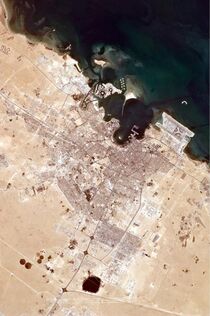
Doha is located on the central-east portion of Qatar, bordered by the Persian Gulf on its coast. Its elevation is 10 m (33 ft).[68] Doha is highly urbanized. Land reclamation off the coast has added 400 hectares of land and 30 km of coastline.[69] Half of the 22 km2 of surface area which Hamad International Airport was constructed on was reclaimed land.[70] The geology of Doha is primarily composed of weathered unconformity on the top of the Eocene period Dammam Formation, forming dolomitic limestone.[71]
The Pearl is an artificial island in Doha with a surface area of nearly 400 ha (1,000 acres)[72] The total project has been estimated to cost $15 billion upon completion.[73] Other islands off Doha's coast include Palm Tree Island, Shrao's Island, Al Safliya Island, and Alia Island.[74]
In a 2010 survey of Doha's coastal waters conducted by the Qatar Statistics Authority, it was found that its maximum depth was 7.5 meters (25 ft) and minimum depth was 2 meters (6 ft 7 in). Furthermore, the waters had an average pH of 7.83, a salinity of 49.0 psu, an average temperature of 22.7 °C and 5.5 mg/L of dissolved oxygen.[75]
Climate
Doha has a hot desert climate (Köppen climate classification BWh) with long, extremely hot summers and short, mild to warm winters. The average high temperatures between May and September surpass 38 °C (100 °F) and often approach 45 °C (113 °F). Humidity is usually the lowest in May and June. Dewpoints can surpass 30 °C (86 °F) in the summer. Throughout the summer, the city averages almost no precipitation, and less than 20 mm (0.79 in) during other months.[76] Rainfall is scarce, at a total of 75 mm (2.95 in) per year, falling on isolated days mostly between October and March. The winter's days are relativity warm while the sun is up and cool during the night. The temperature rarely drops below 7 °C (45 °F).[77] The highest temperature recorded was 50.4 °C (122.7 °F) on 14 July 2010, which is the highest temperature to have ever been recorded in Qatar.[78]
Script error: No such module "weather box".
| Sea Climate Data For Doha | |||||||||||||
|---|---|---|---|---|---|---|---|---|---|---|---|---|---|
| Month | Jan | Feb | Mar | Apr | May | Jun | Jul | Aug | Sep | Oct | Nov | Dec | Year |
| Average sea temperature °C (°F) | style="Template:Weather box/colsea"|21.0 (69.8) |
style="Template:Weather box/colsea"|19.4 (66.9) |
style="Template:Weather box/colsea"|20.9 (69.6) |
style="Template:Weather box/colsea"|23.3 (73.9) |
style="Template:Weather box/colsea"|27.8 (82) |
style="Template:Weather box/colsea"|30.5 (86.9) |
style="Template:Weather box/colsea"|32.4 (90.3) |
style="Template:Weather box/colsea"|33.6 (92.5) |
style="Template:Weather box/colsea"|32.8 (91) |
style="Template:Weather box/colsea"|30.8 (87.4) |
style="Template:Weather box/colsea"|27.5 (81.5) |
style="Template:Weather box/colsea"|23.5 (74.3) |
style="Template:Weather box/colsea"|26.9 (80.5) |
| Source:[81] | |||||||||||||
Demographics
| Historical population | ||
|---|---|---|
| Year | Pop. | ±% p.a. |
| 1820[17] | 250 | — |
| 1893[39] | 6,000 | +4.45% |
| 1970[82] | 80,000 | +3.42% |
| 1986[3] | 217,294 | +6.44% |
| 1998[83] | 264,009 | +1.64% |
| 2001[84] | 299,300 | +4.27% |
| 2004[3] | 339,847 | +4.33% |
| 2005[85][86] | 400,051 | +17.72% |
| 2010[87] | 796,947 | +14.78% |
| 2015[1] | 956,457 | +3.72% |
| Total population of the Doha metropolitan area[88] | |
|---|---|
| Year | Metro population |
| 1997 | 434,000[58] |
| 2004 | 644,000[89] |
| 2008 | 998,651[90] |
A significant portion of Qatar's population lives within Doha and its metropolitan area.[91] The district with the highest population density is the central area of Al Najada, which also accommodates the highest total population in the country. The population density across the greater Doha region ranges from 20,000 people per km2 to 25-50 people per km2.[92] Doha witnessed explosive growth rates in population in the first decade of the 21st century, absorbing the majority of the thousands of people then immigrating to Qatar every month.[93]:6 Doha's population is around one million, with the population of the city more than doubling from 2000 to 2010.[1]
Ethnicity and languages
The population of Doha is overwhelmingly composed of expatriates, with Qatari nationals forming a minority. The largest portion of expatriates in Qatar are from South-East and South Asian countries, mainly India , Pakistan , Sri Lanka, Nepal, Philippines , and Bangladesh with large numbers of expatriates also coming from the Levant Arab countries, Djibouti, Somalia, North Africa, and East Asia. Doha is also home to many expatriates from Europe, North America, South Africa and Australia .[94]
Arabic is the official language of Qatar. English is commonly used as a second language,[95] and a rising lingua franca, especially in commerce.[96] As there is a large expatriate population in Doha, languages such as Malayalam, Tamil, Bengali, Tagalog, Spanish, Sinhala, French, Urdu and Hindi are widely spoken.[94]
| Registered live births in Doha by nationality[88][97][98] | |||
|---|---|---|---|
| Year | Qatari | Non-Qatari | Total |
| 2001 | 2,080 | 3,619 | 5,699 |
| 2002 | 1,875 | 3,657 | 5,532 |
| 2003 | 2,172 | 4,027 | 6,199 |
| 2004 | 2,054 | 3,760 | 5,814 |
| 2005 | 1,767 | 3,899 | 5,666 |
| 2006 | 1,908 | 4,116 | 6,024 |
| 2007 | 1,913 | 4,708 | 6,621 |
| 2008 | 1,850 | 5,283 | 7,133 |
| 2009 | 2,141 | 5,979 | 8,120 |
| 2010[99] | 1,671 | 5,919 | 7,590 |
| 2011[100] | 1,859 | 6,580 | 8,439 |
| 2015 | 1,949 | 9,215 | 11,164 |
| 2020 | 4,005 | 15,381 | 19,386 |
In 2004, the Foreign Ownership of Real Estate Law was passed, permitting non-Qatari citizens to buy land in designated areas of Doha, including the West Bay Lagoon, the Qatar Pearl, and the new Lusail City.[63] Prior to this, expatriates were prohibited from owning land in Qatar. Ownership by foreigners in Qatar entitles them to a renewable residency permit, which allows them to live and work in Qatar.[91]
Religion
The majority of residents in Doha are Muslim.[101] Catholics account for over 90% of the 150,000 Christian population in Doha.[102] Following decrees by the Emir for the allocation of land to churches, the first Catholic church, Our Lady of the Rosary, was opened in Doha in March 2008. The church structure is discreet and Christian symbols are not displayed on the outside of the building.[103] Several other churches exist in Doha, including the St.Isaac and St. George Greek Orthodox Church of Qatar, Doha, Qatar St.Isaac and St. George Greek Orthodox Church of Qatar the Syro-Malabar Church, Malankara Orthodox Church, Mar Thoma Church (affiliated with the Anglicans, but not part of the Communion), CSI Church, Syro-Malankara Church and a Pentecostal church. A majority of mosques are either Salafi or Sunni-oriented.[104]
Administration
Districts
At the turn of the 20th century, Doha was divided into 9 main districts.[105] In the 2010 census, there were more than 60 districts recorded in Doha Municipality.[106] Some of the districts of Doha include:
Shortly after Qatar gained independence, many of the districts of old Doha including Al Najada, Al Asmakh and Old Al Hitmi faced gradual decline and as a result, much of their historical architecture has been demolished.[107] Instead, the government shifted their focus toward the Doha Bay area, which housed districts such as Al Dafna and West Bay.[107]
Economy
Doha is the economic center of Qatar. The city is the headquarters of numerous domestic and international organizations, including the country's largest oil and gas companies, QatarEnergy and QatarEnergy LNG. Doha's economy is built primarily on the revenue the country has made from its oil and natural gas industries.[108] Doha was included in Fortune's 15 best new cities for business in 2011.[109]Beginning in the late 20th century, the government launched numerous initiatives to diversify the country's economy in order to decrease its dependence on oil and gas resources. Doha International Airport was constructed in a bid to solidify the city's diversification into the tourism industry.[108] This was replaced by Hamad International Airport in 2014. The new airport is almost twice the size of the former and features two of the longest runways in the world.[110] Thirty-nine new hotels were under construction in the city in 2011.[111]
As a result of Doha's rapid population boom and increased housing demands, real estate prices rose significantly through 2014.[112] Real estate prices experienced a further spike after Qatar won the rights to host the 2022 FIFA World Cup.[113] Al Asmakh, a Qatari real estate firm, released a report in 2014 which revealed substantial increases in real estate prices following a peak in 2008. Prices increased 5 to 10% in the first quarter of 2014 from the end of 2013.[112][114] A 2015 study conducted by Numbeo, a crowd-sourced database, named Doha as the 10th most expensive city to live in globally.[115] This rate of growth led to the development of planned communities in and around the city.[116] Although the fall in oil prices since 2014 and a diplomatic crisis with Qatar's neighbors slowed growth in the city's population, government spending was increased to maintain the growth in real estate in metropolitan Doha.[117] Doha's hosting of the FIFA world cup in 2022 is said to have been a major Qatari soft power city image branding success.[118][119][120][121]
Expatriate workers remitted $60bn between 2006 and 2012, with 54 percent of the workers' remittances of $60bn routed to Asian countries, followed by Arab nations that accounted for nearly half that volume (28 percent). India was the top destination of the remittances, followed by the Philippines, while the US, Egypt and the neighbouring UAE followed.[122] Remittances in 2014 totaled $11.2 billion, amounting to 5.3% of Qatar's GDP.[123]:45
Tourism and retail
Doha is considered as the most important tourist city in Qatar. Qatar tourism sector is also a key focus of its economic diversification strategy. The country is investing in the development of new tourism infrastructure, such as hotels and resorts, and promoting its cultural attractions, such as the Museum of Islamic Art and the Katara Cultural Village to attract visitors from around the world. In addition, Qatar Airways has become one of the world's leading airlines, connecting the country to major cities across the globe. Qatar has also been attracting major international events to the country, such as the FIFA World Cup 2022, which is expected to generate significant revenue for the country and boost its tourism sector. High and rising incomes in Qatar offer significant opportunities in food and drink and grocery retail sectors. Premium and healthy brands are especially well received. Convenience food is also an increasingly important sector for younger Qataris and visitors.[124]In recent years, Qatar has been taking steps to diversify its economy and reduce its reliance on oil and gas revenues. The country has launched a number of initiatives aimed at promoting non-oil sectors such as tourism, finance, and technology. For example, Qatar has invested heavily in building world-class infrastructure, including the Hamad International Airport and the Qatar Free Zones Authority, to attract foreign investors and businesses to set up shop in the country. Moreover, Qatar has also been working towards creating a more business-friendly environment by streamlining regulations and offering incentives to start-ups and small businesses. The country ambition in this area can already be seen in developments like the recently completed M7 building in downtown Doha. This futuristic five story construction is described as an epicentre for innovation and entrepreneurship in design, fashion and technology.[125]The latest research by the World Travel and Tourism Council (WTTC) which highlighted the top 10 cities where international travelers spent the most in 2022, showed Doha, Qatar at the number 2 spot with $16.8 bn.[126]Qatar has received over 2.56 million visitors from January until 25 August 2023, exceeding the full year arrival figures from 2022, representing a 157 per cent increase over the same period last year, according to a report by Zawya citing figures released yesterday by Qatar Tourism (QT).[127][128]Doha named Arab tourism capital for 2023. Non-GCC tourists made up 66% of all visitors in October, an increase of 10% from the previous month 2023.[129] Doha in 2023 hosted International Horticultural Expo 2023, Spanning 1.7 million square meters, the event takes place in Al Bidda Park, one of the biggest parks in Doha which overlooks the Persian Gulf. [130][131][132]
Infrastructure
Architecture
Many of the older structures (1960–1970s) in the Old Doha districts have been demolished to make space for new buildings.[107] A number of schemes have been taken to preserve the city's cultural and architectural heritage, such as the Qatar Museums Authority's 'Al Turath al Hai' ('living heritage') initiative.[133] Katara Cultural Village is a model village in Doha launched by Sheikha Moza bint Nasser under Qatar Foundation to preserve the cultural identity of the country.[134]
In 2011, more than 50 towers were under construction in Doha,[111] the largest of which was the Doha Convention Center Tower.[135] Constructions were suspended in 2012 following concerns that the tower would impede flight traffic[136] and the site is being redeveloped into a park.
In 2014, Abdullah Al Attiyah, a senior government official, announced that Qatar would be spending $65bn on new infrastructure projects in upcoming years in preparation for the 2022 World Cup as well as progressing towards its objectives set out in the Qatar National Vision 2030.[137]
Msheireb Downtown Doha, a 31 hectares development costing an estimated $5bn, was dubbed the largest inner city redevelopment of its kind when launched. Comprises several quarters opened over different phases, Msheireb aims to preserve and enhance the historic downtown area.
National Museum of Qatar
The new National Museum of Qatar (NMoQ) opened to the public on March 28, 2019.[138] The museum features an innovative design by Pritzker Prize-winning architect Jean Nouvel[139] that is inspired by the desert rose and grows organically around the original 20th century palace of Sheikh Abdullah Bin Jassim Al Thani. This important monument to Qatar's past is now preserved as the heart of the new NMoQ.[140] The relation between the new and old building is part of creating the bridge between the past and the present advocated by Sheikha Al Mayassa for it is the way to "define ourselves instead of forever being defined by others celebrating our identity."[141]Located on a 1.5 million-square-foot site at the south end of Doha Corniche, the NMoQ building rises from the sea and is connected to the shore by two pedestrian bridges and a road bridge.
Doha Tower
Doha Tower also known as Burj Doha, and previously named as Burj Qatar and Doha High Rise Office Building,[142] is a high rise tower in West Bay, Doha. On October 18, 2012, the building received the CTBUH Skyscraper Award for the Best Tall Building Worldwide from the CTBUH.[143] The $125-million office building, designed by French architect Jean Nouvel, has a height of 238 metres (781 ft), with 46 stories. The $125 million building, designed by French architect Jean Nouvel, has a height of 238 metres (781 ft), with 46 stories.[144]
Aspire Tower
Aspire Tower, also known as The Torch Doha, is a 300-metre-tall (980 ft) skyscraper hotel located in the Aspire Zone complex in Doha. Designed by architect Hadi Simaan and AREP and engineer Ove Arup and Partners,[145] the tower served as the focal point for the 15th Asian Games hosted by Qatar in December 2006. The tower is currently the tallest structure and building in Doha and Qatar.
Museum of Islamic Art
Museum of Islamic Art, MIA is a museum on one end of the seven-kilometer-long (4.3 mi) Corniche in Doha. As per the architect I. M. Pei's specifications, the museum is built on an island off an artificial projecting peninsula near the traditional dhow harbor. A purpose-built park surrounds the edifice on the eastern and southern facades while two bridges connect the southern front facade of the property with the main peninsula that holds the park.[146] The western and northern facades are marked by the harbor showcasing the Qatari seafaring past. In September 2017, Qatar Museums appointed Julia Gonnella as new director of MIA.[147]
Qatar National Library
is a non-profit organization under the umbrella of the Qatar Foundation for Education, Science and Community Development.[148] The plans for the new national library were announced by Sheikha Moza bint Nasser, Chairperson of Qatar Foundation, on 19 November 2012, during a ceremony celebrating the 50th anniversary of the Dar Al Kutub Library, in Doha. Qatar National Library (QNL) is a modern facility that provides the people of Qatar with access to over one million books.
Msheireb Museums
Msheireb Museums is a project by Msheireb Properties which celebrates the histories of four historic heritage houses in the heart of Msheireb Downtown Doha, the capital city of Qatar.[149] Msheireb Museums are an integral part of the inner city's regeneration of the old commercial centre, with its traditional community based lifestyle. The restoration of the four heritage houses Bin Jelmood House, Company House, Mohammed Bin Jassim House and Radwani House into world-class museums is a vital part of the Msheireb Downtown Doha development. The Msheireb Museums are part of the first phase of the Heritage Quarter of Msheireb Properties’ QR20 billion (US$5.5 billion), 310,000 sq m development.[150] The museum was also included in the 2018 world's best new buildings list of the Royal Institute of British Architects.[151]
Atmosphere
Due to excessive heat from the sun during the summer, some Doha-based building companies have implemented various forms of cooling technology to alleviate the extremely torrid climatic conditions. This can include creating optical phenomena such as shadows, as well as more expensive techniques like ventilation, coolants, refrigerants, cryogenics, and dehumidifiers.[152] Discussions regarding temperature control have also been features of various scheduled events involving large crowds.[153] There are other initiatives that attempt to counter the heat by altering working hours, weather alteration methods such as cloud seeding,[154][155] and using whiter and brighter construction materials to increase the albedo effects.[156] Nonetheless, despite these measures, Doha and other areas of Qatar could become uninhabitable for humans due to climate change by the end of the 21st century.[157][158]
Planned communities
One of the largest projects underway in Qatar is Lusail City, a planned community north of Doha which is estimated to be completed by 2020 at a cost of approximately $45bn. It is designed to accommodate 450,000 people.[159] Al Waab City, another planned community under development, is estimated to cost QR15 bn.[160] In addition to housing 8,000 individuals, it will also have shopping malls, educational, and medical facilities.[160] Gewan Island is the latest development of UDC comprising a 400,000 sqm mixed use development.
Transportation
To support the expanding city and increasing numbers of residents and commuters, Qatar has heavily invested in upgrading the infrastructure of Doha and Qatar. Since 2004, Doha has been undergoing a huge expansion to its transportation network, including the addition of new highways, a new airport in 2014, a new seaport in 2016, and an 85 km metro system which went operational in 2019.[161]
Roads
Several expressway projects were delivered by ASHGHAL or the Public Works Authority, including Industrial Area Road, Doha Expressway, Dukhan Highway Central, North Road, Al Sheehaniya Leatooriya Lijmiliya Road, F-Ring Road, and Salwa Road Phase 2. Works include road widening, underpasses, interchanges, stormwater drainage systems, effluent networks, systems networks, and lighting to improve road travel use and improved safety for all road users.
The latest project, expected to be delivered in 2024 is the Sharq Crossing:
"The estimated $12bn Sharq Crossing undertaking will involve three extensions interconnected by subsea tunnels. As per the original design, the intersection will incorporate three scaffolds spreading over between 600 meters and 1,310 meters, connecting Doha's Hamad International Airport with the city's social locale of Katara Cultural Village in the north and the focal business territory of West Bay."
Rail
A third of the Doha Metro is currently fully operational. It consists of four lines: the Red Line, the Gold Line, the Blue Line, and the Green Line. The Blue Line is expected to be completed in the second phase in 2025.[163] Msheireb Station is the transfer station for all of the metro lines.[161]
The Red Line (also known as Coast Line) will extend through Doha, running from Al Khor to Al Wakrah and Hamad Airport via the Red Line North and Red Line South. Doha Metro's Green Line, or Education Line, connects Doha to Education City and Al Riffa. Starting in Old Airport, the Gold Line (also known as Historic Line) will end in Al Rayyan and cover a distance of 30.6 km. Lastly, the Blue Line, or City Line, will only cover the inner city of Doha, and is planned to be semi-circular with a length of 17.5 km.[164]
Air
Doha is served by Hamad International Airport which is Qatar's principal international gateway. The airport opened in 2014, replacing Doha International Airport. The airport is named after the previous Emir of Qatar, Hamad bin Khalifa Al Thani. Hamad International Airport became the first Middle Eastern airport to be awarded the Skytrax's World Best Airport for 2021 in the 2021 World Airport Awards, ending the 7-year dominance of Singapore's Changi Airport.[165] Qatar's Hamad International Airport has been named the World's Best Airport for the second year running. The announcement took place at the Skytrax 2022 World Airport Awards, held at Passenger Terminal EXPO in Paris, France.[166]
Taxi
There are plenty of options for picking up a taxi in Doha. You can hail one off the street, walk to the nearest taxi stand, ask your hotel reception staff to book one for you, or download a taxi app. Most of the taxis in Doha are affiliated with the government-owned Mowasalat company since 2004. They provide a fleet of contemporary taxis that are clean, reliable, efficient and air-conditioned. Karwa taxis stand out thanks to their bright turquoise colour, yet have different roofs depending on the taxi operating company. Careem and Uber most of the online taxis are in Doha.
Education
Doha is the educational center of the country and contains the highest preponderance of schools and colleges.[82] In 1952, the first formal boys' school was opened in Doha. This was proceeded by the opening of the first formal girls' school three years later.[167] The first university in the state, Qatar University, was opened in 1973.[168] It provided separate faculties for men and women.[169]
Education City, a 14 km2 (5.4 sq mi) education complex launched by non-profit organization Qatar Foundation, began construction in 2000.[170] It houses eight universities, the country's top high school, and offices for Al Jazeera's children television channel.[170] It is geographically located in Al Rayyan municipality's Al Luqta, Al Gharrafa, Gharrafat Al Rayyan and Al Shagub districts, but falls under the umbrella of Metropolitan Doha.[12]
In 2009, the government launched the World Innovation Summit for Education (WISE), a global forum that brings together education stakeholders, opinion leaders and decision makers from all over the world to discuss educational issues.[171] The first edition was held in Doha in November 2009.[172]
Some of the universities in Doha include:
Sports
Football
Football is the most popular sport in Doha. There are six Doha-based sports clubs with football teams competing in the Qatar Stars League, the country's top football league. They are Al Ahli, Al Arabi, Al Sadd, Al-Duhail and Qatar SC.[175] Al Sadd, Al Arabi and Qatar SC are the three most successful teams in the league's history.[176]
Numerous football tournaments have been hosted in Doha. The most prestigious tournaments include the 1988 and 2011 editions of the AFC Asian Cup[177] and the 1995 FIFA World Youth Championship.[60]
In December 2010, Qatar won the rights to host the 2022 FIFA World Cup.[178] Three of the nine newly announced stadiums will be constructed in Doha, including Sports City Stadium, Doha Port Stadium, and Qatar University Stadium. Additionally, the Khalifa International Stadium is set to undergo an expansion.[179]
Considering the country's rapid development for the 2022 World Cup, FIFA awarded the hosting rights of 2019 FIFA Club World Cup and 2020 FIFA Club World Cup also to Qatar.[180]
Basketball
Doha was the host of the official 2005 FIBA Asia Championship, where Qatar's national basketball team finished 3rd, its best performance to date, and subsequently qualified for the Basketball World Cup.[181]
The majority of the teams that make up the official Qatari Basketball League are based in Doha.
Volleyball
Doha four times was the host of the official FIVB Volleyball Men's Club World Championship and three times host FIVB Volleyball Women's Club World Championship. Doha also hosted the Asian Volleyball Championship.[182]
Other sports
In 2001, Qatar became the first country in the Middle East to hold a women's tennis tournament with the inauguration of its Qatar Ladies Open tournament.[183] Doha also hosts International Tennis Federation (ITF) ladies tournaments. Since 2008, the Sony Ericsson Championships (equivalent to the ATP's season-ending Championships) has taken place in Doha, in the Khalifa International Tennis Complex, and features record prize money of $4.45 million, including a check of $1,485,000 for the winner, which represents the largest single guaranteed payout in women's tennis.[184]
Doha hosted the 15th Asian Games, held in December 2006, spending a total of $2.8 billion for its preparation.[185] The city also hosted the 3rd West Asian Games in December 2005.[186] Doha was expected to host the 2011 Asian Indoor Games; but the Qatar Olympic Committee cancelled the event.[187]
The city submitted a bid for the 2016 Olympics.[188] On June 4, 2008, the city was eliminated from the shortlist for the 2016 Olympic Games. On August 26, 2011, it was confirmed that Doha would bid for the 2020 Summer Olympics.[189] Doha however failed to become a Candidate City for the 2020 Games.[190]
The MotoGP motorcycling grand prix of Doha is held annually at Losail International Circuit, located just outside the city boundaries.[191] The city is also the location of the Grand Prix of Qatar for the F1 Powerboat World Championship, annually hosting a round in Doha Bay.[192] Beginning in November 2009, Doha has been host of The Oryx Cup World Championship, a hydroplane boat race in the H1 Unlimited season. The races take place in Doha Bay.[193]
In April 2012 Doha was awarded both the 2014 FINA World Swimming Championships[194] and the 2012 World Squash Championships.[195] The fourth World Mindsports Championships took place in Doha from August 19 to August 27, 2017, with the participation of more than 1,000 competitors.[196]
In 2014, Qatar was selected as the host of the 2019 World Athletics Championships, which is the seventeenth edition of the IAAF World Athletics Championships.[197] Doha won the bid to host the event over Barcelona and Eugene.[198]
In 2020, Doha hosted the Qatar ExxonMobil Open, which received the Tournament of the Year award in the 250 category from the 2019 ATP Awards. The tournament won the award for the third time in five years.[199]
Doha will host the 2030 Asian Games.[200]
Stadiums and sport complexes
Aspire Academy was launched in 2004 with the aim of creating world-class athletes. It is situated in the Doha Sports City Complex, which also accommodates the Khalifa International Stadium, the Hamad Aquatic Centre, the Aspire Tower and the Aspire Dome. The latter has hosted more than 50 sporting events since its inception, including some events during the 2006 Asian Games.[201] Aspire Academy, a sporting academy for youth, is located in the center of Aspire Zone.[202]
Sporting venues in Doha and its suburbs include:
Culture
Doha was chosen as the Arab Capital of Culture in 2010.[203] Cultural weeks organized by the Ministry of Culture, which featured both Arab and non-Arab cultures, were held in Doha from April to June to celebrate the city's selection.[204]
Arts
The Museum of Islamic Art or MIA in Doha, opened in 2008, is regarded as one of the best museums in the region.[205] This, and several other Qatari museums located in the city, like the Arab Museum of Modern Art, falls under the Qatar Museums Authority (QMA) which is led by Sheikha Al-Mayassa bint Hamad bin Khalifa Al-Thani, the sister of the emir of Qatar.[206]
The National Museum of Qatar, which was constructed in place of the original Qatar National Museum, opened to the public on 28 March 2019.
Cinema
The Doha Film Institute (DFI) is an organisation established in 2010 to oversee film initiatives and create a sustainable film industry in Qatar. DFI was founded by H.E. Sheikha Al Mayassa bint Hamad bin Khalifa Al-Thani.[207]
The Doha Tribeca Film Festival (DTFF), partnered with the American-based Tribeca Film Festival, was held annually in Doha from 2009 to 2012.[208] It emanated from a collaboration between the Doha Film Institute and Tribeca Enterprises.[209] Celebrities such as Robert De Niro,[210] Salma Hayek,[211] Adel Emam,[212] Mira Nair,[213] and Kevin Spacey[214] attended the festivals.[215] The festivals and premieres took place in the Katara Cultural Village[216] every year as well as The Museum of Islamic Art, Doha[217] in 2012. The DTFF premiered up to 87 films from all around the world.[218] The major cinema operators in Doha are Vox, NOVO and Flik.[219]
Media
Qatar's first radio station, Mosque Radio, began broadcasting in the 1960s from Doha.[220] The multinational media conglomerate Al Jazeera Media Network is based in Doha with its wide variety of channels of which Al Jazeera Arabic, Al Jazeera English, Al Jazeera Documentary Channel, Al Jazeera Mubasher, beIN Sports Arabia and other operations are based in the TV Roundabout in the city.[221] Al-Kass Sports Channel's headquarters is also located in Doha.[222] Al Jazeera Media Network serves as the overarching entity overseeing Al Jazeera English, Al Jazeera Arabic, AJ+ along with a host of other fact-based media endeavors that bear the same distinct brand. Originally conceived as a satellite TV channel delivering Arabic news and current affairs, it has since evolved into a multifaceted media network encompassing various platforms such as online, specialized television channels in numerous languages, and more.
The organization is a private foundation for public benefit under Qatari law. [223][224] Despite allegations of government control, [225] [223] [226] It was founded in 1996 by the then Emir of Qatar Sheikh Hamad bin Khalifa Al Thani.[227]
Theatre
The first official theatre troupe in the country was created in 1972 as the "Qatari Theatrical Troupe". It went on to produce its first play the same year.[228] The next year, a second troupe was founded as the Al Sadd Theatrical Troupe.[229] By 1986, the first company had been founded with the intent of aiding troupes and actors in producing plays.[228] Two further troupes were also created during this period: the Lights Theatrical Troupe and Folk Theatrical Troupe. In 1994, the four troupes were amalgamated into two troupes which were named the Qatari Theatrical Troupe and the Doha Theatrical Troupe.[229] Theatre was introduced to Qatar in the mid-20th century. Theatrical performances are held at Qatar National Theater and at the Qatar National Convention Center in Doha.
Sites and attractions
Doha has many sites and attractions that include The Pearl Island, Qatar National Museum, Aspire Park, Souq Waqif, Katara Cultural Village, Doha Corniche, Aspire Tower, Fanar, Museum of Islamic Art, Doha, Doha Tower, Tornado Tower, Khalifa International Tennis and Squash Complex, Oxygen Park, Doha Golf Club, Galeries Lafayette, Al Hazm Mall, World Trade Center Doha, Mathaf: Arab Museum of Modern Art and Msheireb Downtown Doha.
Twin and Sister Cities
Twin and sister cities of Doha are (as per agreements):
- Tunis, Tunisia (since 1994)[230]
- Alameda, California (since 2004)[231]
- Port Louis, Mauritius (since 2007)[232]
- Beijing, China (since 2008)[233]
- Beit Sahour, Palestine (since 2009)[234]
- Banjul, Gambia (since 2011)[235]
- Algiers, Algeria (since 2013)[236]
- Sarajevo, Bosnia and Herzegovina (since 2018)[237]
- Brasília, Brazil (since 2014)[238]
- Sofia, Bulgaria (since 2012)[239]
- San Salvador, El Salvador (since 2018)[240]
- Tbilisi, Georgia (since 2012)[241]
- Astana, Kazakhstan (since 2011)[242]
- Bishkek, Kyrgyzstan (since 2018)[243]
- Mogadishu, Somalia (since 2014)[244]
- Ankara, Turkey (since 2016)[245]
- Los Angeles, California, United States (since 2016)[246](Despite being acknowledged as an agreement, no mention of it in the official Los Angeles website as the sister city.)
- Miami, Florida, United States (since 2016)[247]
- Libertador, Venezuela (since 2015)[248]
- Charleston, South Carolina, United States(2019)[249]
- Yerevan, Armenia (since 2022)[250]
Gallery
Night in Doha
Aspire Park and Aspire Tower a part of the Aspire zone.
The Katara Cultural Village is designed to be a hub of human interaction connecting theatre, literature, music, visual art, conventions and exhibitions in a planned development on the waterfront.[251]
See also
- Timeline of Doha
- Doha Declaration
- Doha Development Round of World Trade Organization (WTO) talks
- Qatar National Day, which is held in Doha every year on December 18
References
- ↑ 1.0 1.1 1.2 1.3 The Report: Qatar 2016. Oxford Business Group. 2016. p. 17. ISBN 978-1-910068-63-2. https://books.google.com/books?id=twdRDwAAQBAJ&pg=PA17.
- ↑ "Doha municipality accounts for 40% of Qatar population". Gulf Times. 20 October 2015. http://www.gulf-times.com/qatar/178/details/459624/doha-municipality-accounts-for-40%25-of-qatar-population.
- ↑ 3.0 3.1 3.2 3.3 Encyclopædia Britannica. "Doha – Britannica Online Encyclopedia". Britannica.com. https://www.britannica.com/EBchecked/topic/168027/Doha.
- ↑ "Welcome to the 20th World Petroleum Congress". 20wpc.com. http://www.20wpc.com/.
- ↑ Saraiva, Alexia (2 August 2018). "Get To Know The 8 2022 Qatar World Cup Stadiums". https://www.archdaily.com/899352/get-to-know-the-8-2022-qatar-world-cup-stadiums.
- ↑ "Doha Ranked Second Safest City in the World". 29 January 2021. https://apnews.com/press-release/newswire/doha-ranked-second-safest-city-in-the-world-ebdd308aeb695443bc75d3aa701feec0.
- ↑ "Doha Ranked Second-Safest City in the World". 5 February 2021. https://www.globaltravelerusa.com/doha-ranked-second-safest-city-in-the-world/.
- ↑ https://academic.oup.com/book/45355/chapter-abstract/389277092?redirectedFrom=fulltext
- ↑ https://www.researchgate.net/publication/293830469_Promoting_Terror_or_Sport_The_Case_of_Qatar's_International_Image
- ↑ https://journals.sagepub.com/doi/abs/10.1177/0002764216632841?journalCode=absb
- ↑ https://nationalinterest.org/feature/how-qatar%E2%80%99s-soft-power-won-world-cup-206087
- ↑ 12.0 12.1 "District map". The Centre for Geographic Information Systems of Qatar. http://geoportal.gisqatar.org.qa/qmape/index.html.
- ↑ 13.0 13.1 "Historical references to Doha and Bidda before 1850". The Origins of Doha Project. p. 1. https://originsofdoha.files.wordpress.com/2015/03/a-history-of-doha-and-bidda1.pdf.
- ↑ Billecocq, Xavier Beguin (2003). Le Qatar et les Français: cinq siècles de récits de voyage et de textes d'érudition. Collection Relations Internationales & Culture. ISBN 978-2-915273-00-7.
- ↑ Rahman, Habibur (2006). The Emergence Of Qatar. Routledge. p. 34. ISBN 978-0-7103-1213-6.
- ↑ Carter, Robert. "Origins of Doha Season 1 Archive Report". p. 11. https://www.academia.edu/5144073.
- ↑ 17.0 17.1 17.2 "Historical references to Doha and Bidda before 1850". The Origins of Doha Project. p. 2. https://originsofdoha.files.wordpress.com/2015/03/a-history-of-doha-and-bidda1.pdf.
- ↑ Al-Qasimi, Sultan Mohammed (1995). The journals of David Seton in the Gulf 1800-1809. Exeter University Press.
- ↑ H. Rahman (2006), p. 36.
- ↑ 20.0 20.1 20.2 Toth, Anthony. "Qatar: Historical Background." A Country Study: Qatar (Helen Chapin Metz, editor). Library of Congress Federal Research Division (January 1993). This article incorporates text from this source, which is in the public domain.
- ↑ "Historical references to Doha and Bidda before 1850". The Origins of Doha Project. p. 3. https://originsofdoha.files.wordpress.com/2015/03/a-history-of-doha-and-bidda1.pdf.
- ↑ "'Gazetteer of the Persian Gulf. Vol I. Historical. Part IA & IB. J G Lorimer. 1915' [793 (948/1782)"]. qdl.qa. 30 September 2014. http://www.qdl.qa/en/archive/81055/vdc_100023575945.0x000095.
- ↑ 23.0 23.1 23.2 "Historical references to Doha and Bidda before 1850". The Origins of Doha Project. p. 4. https://originsofdoha.files.wordpress.com/2015/03/a-history-of-doha-and-bidda1.pdf.
- ↑ H. Rahman (2006), p. 63.
- ↑ "Historical references to Doha and Bidda before 1850". The Origins of Doha Project. p. 5. https://originsofdoha.files.wordpress.com/2015/03/a-history-of-doha-and-bidda1.pdf.
- ↑ Brucks, G. B. (1985). Memoir descriptive of the Navigation of the Gulf of Persia in R. H. Thomas (ed.) Selections from the records of the Bombay Government No XXIV (1829). New York: Oleander press.
- ↑ Zahlan, Rosemarie Said (1979). The creation of Qatar (print ed.). Barnes & Noble Books. p. 33. ISBN 978-0-06-497965-8.
- ↑ "'Gazetteer of the Persian Gulf. Vol I. Historical. Part IA & IB. J G Lorimer. 1915' [794 (949/1782)"]. qdl.qa. 30 September 2014. http://www.qdl.qa/en/archive/81055/vdc_100023575945.0x000096.
- ↑ 29.0 29.1 "Historical references to Doha and Bidda before 1850". The Origins of Doha Project. pp. 5–6. https://originsofdoha.files.wordpress.com/2015/03/a-history-of-doha-and-bidda1.pdf.
- ↑ H. Rahman (2006), pp. 90–92.
- ↑ 31.0 31.1 "Historical references to Doha and Bidda before 1850". The Origins of Doha Project. p. 6. https://originsofdoha.files.wordpress.com/2015/03/a-history-of-doha-and-bidda1.pdf.
- ↑ 32.0 32.1 "Historical references to Doha and Bidda before 1850". The Origins of Doha Project. p. 7. https://originsofdoha.files.wordpress.com/2015/03/a-history-of-doha-and-bidda1.pdf.
- ↑ "Line of succession: The Al Thani rule in Qatar". Gulf News. 27 June 2013. http://gulfnews.com/news/gulf/qatar/line-of-succession-the-al-thani-rule-in-qatar-1.1201210.
- ↑ "'A collection of treaties, engagements and sanads relating to India and neighbouring countries [... Vol XI containing the treaties, & c., relating to Aden and the south western coast of Arabia, the Arab principalities in the Persian Gulf, Muscat (Oman), Baluchistan and the North-West Frontier Province' [113v] (235/822)"]. Qatar Digital Library. 9 October 2014. http://www.qdl.qa/en/archive/81055/vdc_100023462215.0x000024.
- ↑ "'File 19/243 IV Zubarah' [8r (15/322)"]. Qatar Digital Library. 21 March 2014. http://www.qdl.qa/en/archive/81055/vdc_100023636219.0x000010.
- ↑ "'Gazetteer of the Persian Gulf. Vol I. Historical. Part IA & IB. J G Lorimer. 1915' [801 (956/1782)"]. Qatar Digital Library. 30 September 2014. http://www.qdl.qa/en/archive/81055/vdc_100023575945.0x00009d.
- ↑ H. Rahman (2006), p. 123.
- ↑ H. Rahman (2006), pp. 138–139.
- ↑ 39.0 39.1 39.2 Kurşun, Zekeriya (2002). The Ottomans in Qatar: a history of Anglo-Ottoman conflicts in the Persian Gulf. Istanbul : Isis Press. pp. 16–17. ISBN 978-975-428-213-9.
- ↑ Zahlan, Rosemarie Said (1979). The creation of Qatar (print ed.). Barnes & Noble Books. p. 53. ISBN 978-0-06-497965-8.
- ↑ H. Rahman (2006), p. 152.
- ↑ "Historical references to Doha and Bidda before 1850". The Origins of Doha Project. p. 11. https://originsofdoha.files.wordpress.com/2015/03/a-history-of-doha-and-bidda1.pdf.
- ↑ 43.0 43.1 Florian Wiedmann; Ashraf M. Salama. "Urban evolution of the city of Doha: an investigation into the impact of economic transformations on urban structures". p. 38. http://jfa.arch.metu.edu.tr/archive/0258-5316/2012/cilt29/sayi_2/35-61.pdf.
- ↑ 44.0 44.1 Althani, Mohamed (2013). Jassim the Leader: Founder of Qatar. Profile Books. p. 35. ISBN 978-1-78125-070-9. https://books.google.com/books?id=X_J9kiBRdIgC. Retrieved 14 June 2015.
- ↑ Casey, Paula; Vine, Peter (1991). The heritage of Qatar (print ed.). Immel Publishing. pp. 49–50. ISBN 978-0-907151-50-0. https://archive.org/details/heritageofqatar00vinerich/page/49.
- ↑ "'Gazetteer of the Persian Gulf. Vol. II. Geographical and Statistical. J G Lorimer. 1908' [487 (536/2084)"]. Qatar Digital Library. 30 September 2014. https://www.qdl.qa/en/archive/81055/vdc_100023515713.0x000089. This article incorporates text from this source, which is in the public domain.
- ↑ "'Gazetteer of the Persian Gulf. Vol. II. Geographical and Statistical. J G Lorimer. 1908' [488 (537/2084)"]. Qatar Digital Library. 30 September 2014. https://www.qdl.qa/en/archive/81055/vdc_100023515713.0x00008a.
- ↑ 48.0 48.1 "'Gazetteer of the Persian Gulf. Vol. II. Geographical and Statistical. J G Lorimer. 1908' [489 (540/2084)"]. Qatar Digital Library. 30 September 2014. https://www.qdl.qa/en/archive/81055/vdc_100023515713.0x00008d. This article incorporates text from this source, which is in the public domain.
- ↑ M. Althani (2013), p, 134.
- ↑ H. Rahman (2006), p. 291.
- ↑ "Historical references to Doha and Bidda before 1850". The Origins of Doha Project. p. 16. https://originsofdoha.files.wordpress.com/2015/03/a-history-of-doha-and-bidda1.pdf.
- ↑ "Pearl Diving in Qatar". USA Today. http://traveltips.usatoday.com/pearl-diving-qatar-100698.html.
- ↑ Abu Saud, Abeer (1984). Qatari Women: Past and Present. Longman Group. p. 173. ISBN 978-0-582-78372-0.
- ↑ "Qatar in perspective: an orientation guide". Defense League Institute Foreign Language Center. 2010. p. 8. https://famdliflc.lingnet.org/products/cip/qatar/qatar.pdf.
- ↑ Florian Wiedmann; Ashraf M. Salama. "Urban evolution of the city of Doha: an investigation into the impact of economic transformations on urban structures". p. 41. http://jfa.arch.metu.edu.tr/archive/0258-5316/2012/cilt29/sayi_2/35-61.pdf.
- ↑ "Our history". Qatar University. http://www.qu.edu.qa/theuniversity/history.php.
- ↑ "Qatar's National Museum eyeing 2016 opening". Doha News. 6 July 2014. http://dohanews.co/qatars-national-museum-eyeing-2016-opening/.
- ↑ 58.0 58.1 58.2 Florian Wiedmann; Ashraf M. Salama. "Urban evolution of the city of Doha: an investigation into the impact of economic transformations on urban structures". pp. 44–45. http://jfa.arch.metu.edu.tr/archive/0258-5316/2012/cilt29/sayi_2/35-61.pdf.
- ↑ 59.0 59.1 Florian Wiedmann; Ashraf M. Salama. "Urban evolution of the city of Doha: an investigation into the impact of economic transformations on urban structures". p. 47. http://jfa.arch.metu.edu.tr/archive/0258-5316/2012/cilt29/sayi_2/35-61.pdf.
- ↑ 60.0 60.1 "FIFA World Youth Championship Qatar 1995 – matches". FIFA. https://www.fifa.com/u20worldcup/archive/qatar1995/matches/index.html.
- ↑ "AL JAZEERA TV: The History of the Controversial Middle East News Station Arabic News Satellite Channel History of the Controversial Station". Allied-media. http://allied-media.com/aljazeera/jazeera_history.html.
- ↑ Florian Wiedmann; Ashraf M. Salama. "Urban evolution of the city of Doha: an investigation into the impact of economic transformations on urban structures". p. 49. http://jfa.arch.metu.edu.tr/archive/0258-5316/2012/cilt29/sayi_2/35-61.pdf.
- ↑ 63.0 63.1 Wiedmann, Florian; Salama, Ashraf M (2013). Demystifying Doha: On Architecture and Urbanism in an Emerging City. Ashgate. ISBN 978-1-4094-6634-5. https://books.google.com/books?id=fk6iAgAAQBAJ.
- ↑ Khalil Hanware (21 March 2005). "Pearl-Qatar Towers Lure International Investors". Arab News (Jeddah). http://www.arabnews.com/node/264071.
- ↑ Exell, Karen; Rico, Trinidad (2014). Cultural Heritage in the Arabian Peninsula: Debates, Discourses and Practices. Ashgate. p. 199. ISBN 978-1-4094-7009-0.
- ↑ Elspeth Black. "Katara: The Cultural Village". The Culture Trip. http://theculturetrip.com/middle-east/qatar/articles/katara-the-cultural-village/.
- ↑ 67.0 67.1 67.2 "Doha Development Agenda - Trade - European Commission". https://ec.europa.eu/trade/policy/eu-and-wto/doha-development-agenda/.
 Material was copied from this source, which is available under a Creative Commons Attribution 4.0 International License .
Material was copied from this source, which is available under a Creative Commons Attribution 4.0 International License .
- ↑ "Map of Doha, Qatar". Climatemps.com. http://www.qatar.climatemps.com/map.php.
- ↑ "New land by the sea: Economically and socially, land reclamation pays". International Association of Dredging Companies. p. 4. https://www.iadc-dredging.com/ul/cms/fck-uploaded/documents/PDF%20Articles/article-new-land-by-the-sea.pdf.
- ↑ "DEME: Doha Airport Built on Reclaimed Land Becomes Fully Operational". Dredging Today. 3 June 2014. http://www.dredgingtoday.com/2014/06/03/deme-doha-airport-built-on-reclaimed-land-becomes-fully-operational/.
- ↑ Ed Blinkhorn (April 2015). "Geophysical GPR Survey". The Origins of Doha Project. https://originsofdoha.files.wordpress.com/2015/06/2015090-7235-bidda-gpr-report.pdf.
- ↑ Ron Gluckman (May 2008). "Artificial Islands: In Dubai, a world, and universe of new real estate". Gluckman. http://www.gluckman.com/ArtificialIslands.html.
- ↑ "Say Hello To Pearl Qatar – The World's Most Luxurious Artificial Island". Wonderful Engineering. 12 December 2014. http://wonderfulengineering.com/say-hello-to-pearl-qatar-the-worlds-most-luxurious-artificial-island/.
- ↑ "Qatar islands". Online Qatar. http://www.onlineqatar.com/attractions/islands-qatar.aspx.
- ↑ "Qatar Infrastructure Statistics". Qatar Statistics Authority. May 2012. p. 29. https://www.mdps.gov.qa/en/knowledge/Publications/Economic/Eco_Qatar_Infrastructure_Statistics_En_2012.pdf.
- ↑ "Doha weather information". Wunderground.com. 2010-06-10. http://www.wunderground.com/NORMS/DisplayIntlNORMS.asp?CityCode=41170&Units=both.
- ↑ 77.0 77.1 "Doha International Airport Climate Normals 1962-1992". National Oceanic and Atmospheric Administration. ftp://ftp.atdd.noaa.gov/pub/GCOS/WMO-Normals/RA-II/QR/41170.TXT.
- ↑ Masters, Jeff. "Bolivia ties its all-time heat record". Weather Underground. Dr. Jeff Masters' WunderBlog. http://www.wunderground.com/blog/JeffMasters/comment.html?entrynum=1701.
- ↑ "Climate Information For Doha" (in en). Qatar Meteorological Department. http://www.qweather.gov.qa/ClimateInfo.aspx.
- ↑ "41170: Doha International Airport (Qatar)". OGIMET. 19 March 2021. https://www.ogimet.com/cgi-bin/gsynres?ind=41170&ano=2021&mes=3&day=19&hora=0&min=0&ndays=30.
- ↑ "Doha Sea Temperature". https://www.seatemperature.org/middle-east/qatar/doha-march.htm.
- ↑ 82.0 82.1 Abdulla Juma Kobaisi. "The Development of Education in Qatar, 1950–1970". Durham University. p. 11. http://etheses.dur.ac.uk/1856/1/1856.pdf.
- ↑ Hassan Khayat; Ismail Amer; Saleh Arifi; Ahmed Babaker; Bassam Nasr; Nizam Shafei; Fatimah Al Kuwari; Ali Ibrahim Sheib et al. (1998) (in ar). موسوعة المعلومات القطرية (Qatar Information Encyclopedia). Qatar University. p. 235. https://qspace.qu.edu.qa/handle/10576/4866. Retrieved 25 August 2018.
- ↑ "Doha". Tiscali.co.uk. 1984-02-21. http://www.tiscali.co.uk/reference/encyclopaedia/hutchinson/m0003599.html.
- ↑ "Sheraton Doha Hotel & Resort | Hotel discount bookings in Qatar". Hotelrentalgroup.com. http://www.hotelrentalgroup.com/Qatar/Sheraton%20Doha%20Hotel%20&%20Resort.htm.
- ↑ "hotelsdoha.eu". hotelsdoha.eu. http://www.hotelsdoha.eu/.
- ↑ "Qatar population statistics". geohive.com. http://www.geohive.com/cntry/qatar.aspx.
- ↑ 88.0 88.1 "Population statistics". Qatar Information Exchange. http://www.qix.gov.qa/portal/page/portal/qix/subject_area?subject_area=176.
- ↑ World and Its Peoples. Marshall Cavendish. 2006. p. 61. ISBN 978-0-7614-7571-2. https://books.google.com/books?id=j894miuOqc4C. Retrieved 15 June 2015.
- ↑ "Doha 2016 Summer Olympic Games Bid". GamesBids.com. http://www.gamesbids.com/english/bids/dha2016.shtml.
- ↑ 91.0 91.1 Marco Dilenge. "Dubai and Doha: Unparalleled Expansion". Crown Records Management UK. http://web.crownrms.com/crown/Publicit.nsf/58d4471085c17e844825692e00167a60/11991e6448f008d248257393001008a0/$FILE/Dubai%20and%20Doha%20Unparalled%20Expansion%20by%20Marco%20Dilenge.pdf.
- ↑ "Facts and figures". lusail.com. http://www.lusail.com/English/Background/Pages/Facts-and-Figures.aspx.
- ↑ De Bel-Air, Françoise (2017). Demography, Migration, and the Labour Market in Qatar (Report). European University Institute and the Gulf Research Center. GLMM - EN - No. 3/2017. https://gulfmigration.org/media/pubs/exno/GLMM_EN_2017_03.pdf. Retrieved 2020-03-21.
- ↑ 94.0 94.1 Humaira Tasnim; Abhay Valiyaveettil. "Socio-geographic map of Doha". Qatar Computing Research Institute. http://www.qcri.com/app/media/2222.
- ↑ Baker, Colin; Jones, Sylvia Prys (1998). Encyclopedia of Bilingualism and Bilingual Education. Multilingual Matters. p. 429. ISBN 978-1-85359-362-8. https://books.google.com/books?id=YgtSqB9oqDIC. Retrieved 16 June 2015.
- ↑ Guttenplan, D. D. (11 June 2012). "Battling to Preserve Arabic From English's Onslaught". The New York Times. https://www.nytimes.com/2012/06/11/world/middleeast/11iht-educlede11.html.
- ↑ "WELCOME TO Qatar Statistics Authority WEBSITE". Qsa.gov.qa. http://www.qsa.gov.qa.
- ↑ "Statistics: Births & Deaths". Qatar Planning & Statistics Authority. https://www.psa.gov.qa/en/statistics1/pages/topicslisting.aspx?parent=Population&child=BirthsDeaths.
- ↑ "Births and deaths in 2010". Qatar Statistics Authority. http://www.qix.gov.qa/portal/page/portal/QIXPOC/Documents/QIX%20Knowledge%20Base/Publication/Population%20Statistics/Vital/Source_QSA/Births_Deaths_Foetal_Deaths_QSA_AnBu_AE_2010.pdf.
- ↑ "Births and deaths in 2011". Qatar Statistics Authority. http://www.qix.gov.qa/portal/page/portal/QIXPOC/Documents/QIX%20Knowledge%20Base/Publication/Population%20Statistics/Vital/Source_QSA/Births_Deaths_Foetal_Deaths_QSA_AnBu_AE_2011.pdf.pdf.
- ↑ "Religious demography of Qatar". US Department of State. http://globalreligiousfutures.org/countries/qatar/religious_demography.pdf.
- ↑ Shabina Khatri (20 June 2008). "Qatar opens first church, quietly". Al Jazeera. http://www.aljazeera.com/news/middleeast/2008/03/2008525173738882540.html.
- ↑ Sonia Verma (14 March 2008). "Qatar hosts its first Christian church". The Times. http://www.thetimes.co.uk/tto/faith/article2099049.ece.
- ↑ Oman Economic and Development Strategy Handbook, International Business Publications, USA - 2009, page 40
- ↑ Jaidah, Ibrahim; Bourennane, Malika (2010). The History of Qatari Architecture 1800-1950. Skira. p. 25. ISBN 978-88-6130-793-3.
- ↑ "Census 2010". Qatar Statistics Authority. 2010. http://www.qsa.gov.qa/QatarCensus/Populations.aspx.
- ↑ 107.0 107.1 107.2 Djamel Bouassa. "Al Asmakh historic district in Doha, Qatar: from an urban slum to living heritage". Journal of Architectural Conservation 20 (1): 1–14. https://www.academia.edu/7412457. Retrieved 10 July 2015.
- ↑ 108.0 108.1 Michael Dumper; Bruce E. Stanley (2006). Cities of the Middle East and North Africa: A Historical Encyclopedia. ABC-CLIO. p. 138. ISBN 978-1-57607-919-5. https://books.google.com/books?id=3SapTk5iGDkC&pg=PA138. Retrieved 11 July 2015.
- ↑ Dawsey, Josh; Arora, Rupali. "Global 500 2011: 15 best new cities for business". https://money.cnn.com/magazines/fortune/global500/2011/hottest_cities/.
- ↑ Marco Rinaldi (5 May 2014). "Hamad International Airport by Hok". aasarchitecture.com. http://aasarchitecture.com/2014/05/hamad-international-airport-hok.html.
- ↑ 111.0 111.1 Bullivant, Lucy (2012). Masterplanning Futures. Routledge. p. 59. ISBN 978-0-415-55447-3. https://books.google.com/books?id=7xal23QYDW4C&pg=PA59.
- ↑ 112.0 112.1 Peter Kovessy (23 June 2014). "Reports: Housing supply not keeping up with population rise". Doha News. http://dohanews.co/reports-suggest-looming-housing-shortages-qatar/.
- ↑ Rohan Soman (13 May 2013). "Real estate prices in Qatar skyrocket". BQ Doha. http://www.bqdoha.com/2013/05/real-estate-prices-in-qatar-skyrocket.
- ↑ "Qatar Real Estate Report Q1 2014". Al Asmakh Real Estate Firm. 2014. http://www.alasmakhrealestate.com/images/news/MarketReport/Qatar%20Real%20Estate%20Market%20Report%20Q1%2014.pdf.
- ↑ Neha Batia (5 July 2015). "Doha city rents are world's tenth most expensive". Construction Week Online. http://www.constructionweekonline.com/article-34319-doha-city-rents-are-worlds-tenth-most-expensive/.
- ↑ "Falling oil prices and real estate markets". BQ Doha. 10 March 2015. http://www.bqdoha.com/2015/03/oil-prices-and-real-estate-markets.
- ↑ Kerr, Simeon (17 October 2019). "Qatar pins growth hopes on domestic renewal". Financial Times. https://www.ft.com/content/39f1c556-cf30-11e9-b018-ca4456540ea6.
- ↑ https://academic.oup.com/book/45355/chapter-abstract/389277092?redirectedFrom=fulltext
- ↑ https://www.researchgate.net/publication/293830469_Promoting_Terror_or_Sport_The_Case_of_Qatar's_International_Image
- ↑ https://journals.sagepub.com/doi/abs/10.1177/0002764216632841?journalCode=absb
- ↑ https://nationalinterest.org/feature/how-qatar%E2%80%99s-soft-power-won-world-cup-206087
- ↑ "Expatriates Remit $60bn in 7 years". http://thepeninsulaqatar.com/qatar/235307-expatriates-remit-60bn-in-7-years.html.
- ↑ World Bank Group (2016). Migration and Remittances Factbook 2016 (3rd ed.). World Bank. doi:10.1596/978-1-4648-0319-2. ISBN 978-1-4648-0320-8. https://openknowledge.worldbank.org/handle/10986/23743. Retrieved 21 March 2020.
- ↑ "Qatar looks to World Cup business boost". https://group.atradius.com/press/atradius-news/qatar-looks-to-world-cup-business-boost.html.
- ↑ "M7 is Qatar’s epicenter for innovation and entrepreneurship in design, fashion and tech.". https://qm.org.qa/en/about-us/m7/.
- ↑ "Qatar second globally with $16.8 bn spent by travelers in 2022". https://economymiddleeast.com/news/qatar-second-globally-with-16-8-bn-spent-by-travelers-in-2022/.
- ↑ "Qatar post World Cup sees 157% surge in tourism". https://www.middleeastmonitor.com/20230904-qatar-post-world-cup-sees-157-surge-in-tourism/.
- ↑ "World Cup Brings Two Million Visitors and an Epic Culture Clash to Qatar". https://www.wsj.com/articles/world-cup-qatar-culture-clash-alcohol-11668527466.
- ↑ "Doha named Arab tourism capital for 2023". https://dohanews.co/doha-named-arab-tourism-capital-for-2023/.
- ↑ "About Us". https://www.dohaexpo2023.gov.qa/en/about/.
- ↑ "Expo 2021 Doha". https://www.bie-paris.org/site/en/2021-doha.
- ↑ "Qatar to host Horticultural Expo 2021". 24 November 2018. https://www.thepeninsulaqatar.com/article/24/11/2018/Qatar-to-host-Horticultural-Expo-2021.
- ↑ "The Winners of the Old Doha Prize Competition Announced". Marhaba. 26 November 2013. http://marhaba.qa/the-winners-of-the-old-doha-prize-competition-announced/.
- ↑ "About us". Katara. http://www.katara.net/english/about-katara/about-us/.
- ↑ "The World's Tallest Buildings". Bloomberg. 2010. https://www.bloomberg.com/ss/08/10/1015_tallest_buildings/14.htm.
- ↑ "Flight concerns stop 550m Doha tower development". Construction Week Online. 31 January 2012. http://www.constructionweekonline.com/article-15481-flight-concerns-stop-550m-doha-tower-development/.
- ↑ "Doha rolling out the dough for Qatar infrastructure, set to launch new projects worth $65 billion". 17 March 2014. http://www.albawaba.com/business/qatar-construction-561913.
- ↑ "Expect the unexpected at the new National Museum of Qatar". 2019-03-27. https://www.theartnewspaper.com/2019/03/27/expect-the-unexpected-at-the-new-national-museum-of-qatar.
- ↑ "Jean Nouvel on the Newly Completed National Museum of Qatar" (in en-US). 2019-03-27. https://www.architecturaldigest.com/story/national-museum-of-qatar.
- ↑ National Museum of Qatar
- ↑ Hanley, D.C.. "A Desert Rose takes shape: plans for National Museum of Qatar Unveiled". Washington Report on Middle East Affairs. 4 29: 32–33.
- ↑ Shabinakhatri (20 October 2012). "Chicago group names Burj Qatar best tall building in MENA". Doha News. http://dohanews.co/post/25085090949/chicago-group-names-burj-qatar-best-tall-building-in. Retrieved 14 March 2013.
- ↑ "Doha Tower Named Best Tall Building Worldwide". CTBUH 11th Annual Awards, 2012. Council on Tall Buildings and Urban Habitat. 19 October 2012. http://www.ctbuh.org/Awards/OverviewofPastAwards/2012Awards/tabid/3342/language/en-GB/Default.aspx. Retrieved 14 March 2013.
- ↑ "Chicago group names Burj Qatar best tall building in MENA". Doha News. http://dohanews.co/post/25085090949/chicago-group-names-burj-qatar-best-tall-building-in. Retrieved 14 July 2013.
- ↑ "Sports City Tower, Doha, Qatar". Hadi Simaan. http://www.hadisimaan.com/hospitality/sports_city_tower_doha_qatar/main_picture.html#.
- ↑ "MIA Park". https://www.mia.org.qa/en/mia-park.
- ↑ "Qatar Museums Names Julia Gonnella Director of the Museum of Islamic Art – ARTnews.com". https://www.artnews.com/art-news/news/qatar-museums-names-julia-gonnella-director-of-the-museum-of-islamic-art-9078/.
- ↑ Qatar National Library. "About the library ." Retrieved 2014-12-14.
- ↑ "Msheireb Museums". http://www.msheireb.com/en-us/home/msheirebmuseums.aspx.
- ↑ Walker, Lesley (2015-10-21). "100-year-old houses restored by Msheireb tell Qatar's story" (in en-US). https://dohanews.co/100-year-old-houses-restored-by-msheireb-tell-qatars-story/.
- ↑ "Msheireb Museums in RIBA’s list of best new buildings" (in en). 2018-01-02. https://www.gulf-times.com/story/576818/msheireb-museums-in-ribas-list-of-best-new-buildings.
- ↑ Air Conditioning: A Practical Introduction - Page 106, David V. Chadderton - 2014
- ↑ The Report: Qatar 2012 - Page 187, Oxford Business Group
- ↑ Red Sea and the Persian Gulf - Page 237, 2007
- ↑ Sixth Conference on Planned and Inadvertent Weather Modification, p 307, 1977
- ↑ Hegazy, Ahmed (2016). Plant Ecology in the Middle East. p. 205.
- ↑ Pal, Jeremy S.; Eltahir, Elfatih A. B. (February 2016). "Future temperature in southwest Asia projected to exceed a threshold for human adaptability". Nature Climate Change 6 (2): 197–200. doi:10.1038/nclimate2833. ISSN 1758-6798. OCLC 7248753512. Bibcode: 2016NatCC...6..197P. https://eltahir.mit.edu/wp-content/uploads/2015/10/nclimate2833.pdf. Retrieved 2022-10-07.
- ↑ Schwartz, John (27 October 2015). "Deadly Heat Is Forecast in Persian Gulf by 2100". The New York Times. OCLC 5921460720. https://www.nytimes.com/2015/10/27/science/intolerable-heat-may-hit-the-middle-east-by-the-end-of-the-century.html.
- ↑ Tony Manfred (22 September 2014). "Qatar Is Building A $45 Billion City From Scratch For The World Cup That It Might Lose". http://www.businessinsider.com/lusail-city-qatar-2014-9.
- ↑ 160.0 160.1 "Al Waab City Phase 1 Opens". Qatar Today Online. 11 March 2014. http://www.qatartodayonline.com/al-waab-city-phase-1-opens/.
- ↑ 161.0 161.1 William Skidmore (24 October 2012). "Qatar's key infrastructure projects". Construction Week Online. http://www.constructionweekonline.com/article-19113-qatars-key-infrastructure-projects/.
- ↑ "Sharq Crossing re-launch affirms Qatar's long-term growth". https://www.thepeninsulaqatar.com/article/18/12/2019/Sharq-Crossing-re-launch-affirms-Qatar%E2%80%99s-long-term-growth.
- ↑ "Laying the foundations in Qatar". Trenchless International. 4 July 2017. https://www.trenchlessinternational.com/2017/07/04/laying-foundations-qatar/.
- ↑ "Doha Metro". Railway Technology. https://www.railway-technology.com/projects/doha-metro/.
- ↑ "Hamad International Airport is named the World's Best Airport" (Press release). London: Skytrax. 5 August 2021. Archived from the original on 8 September 2021. Retrieved 6 August 2021.
- ↑ "Hamad International Airport named World's Best Airport 2022". Skytrax. June 2022. https://skytraxratings.com/hamad-international-airport-is-named-the-worlds-best-airport.
- ↑ Abu Saud, Abeer (1984). Qatari Women: Past and Present. Longman Group. p. 173. ISBN 978-0-582-78372-0.
- ↑ "Qatar University". Qatar e-government. http://portal.www.gov.qa/wps/portal/!ut/p/a0/RYyxDsIwDES_hSFzUtjYKoTECqICupnUaqxSO0rcIv6epkun0717Otvap20ZZupBSRg-S399_XiMoMFUh9q4yzSIjGSqvXvgu8RJWJF1m9xdIvls3Lmb_HpUNOCuxA0zQvJh0akPmArbPHcFhZU1TDOmTPqzcah3f7UCsOE!/.
- ↑ Abu Saud (1973), p. 173
- ↑ 170.0 170.1 Simeon Kerr (20 October 2013). "Doha's Education City is a boost for locals". Financial Times. http://www.ft.com/cms/s/0/b2fff52c-1711-11e3-9ec2-00144feabdc0.html#axzz3gD8oJryK.
- ↑ "World Innovation Summit for Education (WISE) 2014". UNESCO. https://en.unesco.org/events/world-innovation-summit-education-wise-2014.
- ↑ "The 2009 World Innovation Summit for Education (WISE) convened November 16-18, in Doha, Qatar under the theme "Global Education: Working Together for Sustainable Achievements"". WISE Qatar. http://www.wise-qatar.org/2009-summit-global-education-working-together-sustainable-achievements.
- ↑ "While U.S. universities see dollar signs in Qatari partnerships, some cry foul". Gulf News Journal. 24 September 2015. http://gulfnewsjournal.com/stories/510639673-while-u-s-universities-see-dollar-signs-in-qatari-partnerships-some-cry-foul.
- ↑ "UCL - London's Global University". March 2018. http://www.ucl.ac.uk/qatar.
- ↑ "Qatar Stars League 2014/2015 » Teams". worldfootball.net. http://www.worldfootball.net/players/qat-qatar-stars-league-2014-2015/.
- ↑ "Qatar Stars League » Champions". worldfootball.net. http://www.worldfootball.net/winner/qat-qatar-stars-league/.
- ↑ "AFC Asian Cup history". AFC Asian Cup. http://www.afcasiancup.com/about/en/e8cj5pyl9r3q1mnhvnallamdh.
- ↑ "2018 and 2022 FIFA World Cup Hosts Announced". BBC News. 2 December 2010. http://news.bbc.co.uk/sport1/hi/football/9250585.stm.
- ↑ "2022 FIFA World Cup Bid Evaluation Report: Qatar". FIFA. 2010-12-05. https://www.fifa.com/mm/document/tournament/competition/01/33/59/45/bidevaluationreport.pdf.
- ↑ "Qatar to host next two FIFA Club World Cups". Al Jazeera. https://www.aljazeera.com/news/2019/06/qatar-host-fifa-club-world-cups-190603170525934.html.
- ↑ 2005 FIBA Asia Championship , ARCHIVE.FIBA.com, Retrieved 5 June 2016.
- ↑ "QVA - Qatar Volleyball Association". http://www.volleyball.qa/en/.
- ↑ "History & Overview". Qatar Tennis Federation. http://www.qatartennis.org/about-us/history-overview/.
- ↑ ""Season to End in Doha 2008–2010" on the Sony Ericsson WTA Tour website". Sonyericssonwtatour.com. http://www.sonyericssonwtatour.com/3/newsroom/stories/?ContentID=1482.
- ↑ Patrick Dixon. "The Future Of Qatar – Rapid Growth". globalchange.com. http://www.globalchange.com/qatar.htm.
- ↑ "Doha 2005: 3rd West Asian Games". Olympic Council of Asia. http://www.ocasia.org/Game/GameParticular.aspx?m3o2sVEZ0pv/KgM749S4mg==.
- ↑ "Qatar Participates in 4th Asian Indoor and Martial Arts Games This Week". Marhaba. 30 June 2013. http://marhaba.qa/qatar-participates-in-th-asian-indoor-and-martial-arts-games-this-week/.
- ↑ "Information on 2016 Olympic Games Bids". Gamesbids.com. http://www.gamesbids.com/english/bids/2016.shtml.
- ↑ "Doha to bid for 2020 Olympics". Espn.go.com. 2011-08-26. http://espn.go.com/olympics/story/_/id/6898802/doha-bid-right-host-2020-summer-olympics.
- ↑ "IOC selects three cities as Candidates for the 2020 Olympic Games". Olympic.org. http://www.olympic.org/news?articleid=160523&articlenewsgroup=-1.
- ↑ "About the circuit". MotoGP. http://www.motogp.com/en/event/Qatar.
- ↑ "Power boats". Oryx in-flight magazine. http://www.oryxinflightmagazine.com/middle-east/power-boats.html.
- ↑ "2014 Oryx Cup Dates Announced". H1 Unlimited. 12 March 2014. http://www.h1unlimited.com/2014/03/2014-oryx-cup-dates-announced/.
- ↑ "Doha awarded 2014 World Short Course Swimming Championships". Insidethegames.biz. 2012-04-04. http://www.insidethegames.biz/sports/summer/aquatics/16470-doha-awarded-2014-world-short-course-swimming-championships.
- ↑ "Doha picked to host 2012 World Squash Championships". Insidethegames.biz. 2012-04-18. http://www.insidethegames.biz/latest/16623-doha-picked-to-host-2012-world-squash-championships.
- ↑ "World Mindsports Championships ends on high note". The Peninsula. 29 August 2017. https://thepeninsulaqatar.com/article/29/08/2017/World-Mindsports-Championships-ends-on-high-note.
- ↑ "Iaaf WC 2019 will be held in Doha, Qatar!". 18 November 2014. https://www.atleticalive.it/iaaf-wc-2019-will-be-held-in-doha-qatar/.
- ↑ "Barcelona, Doha and Eugene – candidate cities for 2019 IAAF World Championships". https://www.iaaf.org/competitions/iaaf-world-championships/news/barcelona-doha-eugene-2019-iaaf-world-champio.
- ↑ "Doha Honored With ATP 250 Tournament Of The Year Award". ATP Tour. https://www.atptour.com/en/news/doha-2020-ceremony-atp-250-tournament-of-the-year.
- ↑ "Mabrouk: Doha to host 2030 Asian Games". The Peninsula. 16 December 2020. https://thepeninsulaqatar.com/article/16/12/2020/Mabrouk-Doha-to-host-2030-Asian-Games.
- ↑ "The Aspire Dome, centre stage for Doha 2010". IAAF Athletics. 3 November 2009. http://www.iaaf.org/news/news/the-aspire-dome-centre-stage-for-doha-2010.
- ↑ Mercy Njue (3 May 2017). "Aspire Academy: Unlocking the potential of Qatar's youth". AIPS Media. http://www.aipsmedia.com/2017/05/03/20787/aspire-academy-aspire-zone-doha-qatar-athletes-mercy-njue.
- ↑ "Irina Bokova receives the Prize 'Doha 2010 Arab Capital of Culture'". UNESCO. 17 December 2010. http://www.unesco.org/new/en/unesco/about-us/who-we-are/director-general/singleview-dg/news/irina_bokova_receives_the_prize_doha_2010_arab_capital_of_culture/#.Va_BdflViko.
- ↑ "Doha, 2010 Arab culture capital, to host Arab and non-Arab cultural weeks". Habib Toumi. 4 April 2010. http://www.habibtoumi.com/2010/04/04/doha-2010-arab-culture-capital-to-host-arab-and-non-arab-cultural-weeks/.
- ↑ "Art in Qatar: A Smithsonian in the sand". The Economist. 1 January 2011. http://www.economist.com/node/17797006.
- ↑ "QMA Board of Trustees". Qatar Museums Authority. http://www.qma.org.qa/online/index.php/en/about-us/board-of-trustees.
- ↑ "Article in Variety Arabia". Tradearabia.com. 2010-05-16. http://www.tradearabia.com/news/MEDIA_179834.html.
- ↑ "Whatever happened to the Qatari film industry?". 6 March 2014. https://www.theguardian.com/film/2014/mar/06/qatari-film-industry-doha-festival-black-gold.
- ↑ "About Us". https://www.tribecafilm.com/about.
- ↑ Kemp, Stuart (2012-11-19). "‘Skyfall’ Writers, Robert De Niro Bring Star Power to Doha Tribeca Film Festival" (in en-US). https://www.hollywoodreporter.com/news/general-news/skyfall-writers-robert-de-niro-doha-film-festival-392007/.
- ↑ "Doha Tribeca Film Festival". https://www.timeoutdoha.com/movies/movies-features/18873-doha-tribeca-film-festival.
- ↑ "Hollywood glamour at Doha film festival" (in en-GB). BBC News. 2010-11-03. https://www.bbc.com/news/world-middle-east-11677079.
- ↑ "Doha Tribeca Film Festival opens in style" (in en). https://www.screendaily.com/doha-tribeca-film-festival-opens-in-style/5049150.article.
- ↑ "The Doha-Tribeca Film Festival: Robert DeNiro, Kevin Spacey and Directors in Burkas" (in en). 2010-11-16. https://www.huffpost.com/entry/the-dohatribeca-film-fest_b_783577.
- ↑ "Robert De Niro opens Doha Tribeca Film Festival" (in en). https://gulfnews.com/entertainment/robert-de-niro-opens-doha-tribeca-film-festival-1.1106400.
- ↑ "Home" (in en-US). http://www.katara.net/en.
- ↑ "The Museum of Islamic Art, Doha, Qatar" (in en-gb). http://www.mia.org.qa/en/.
- ↑ "Red carpet gala to mark Doha Tribeca Film Festival opening". 17 November 2012. https://gulf-times.com/story/333014.
- ↑ "Doha’s best cinemas: Where to watch the latest movies in the city". 2022-04-14. https://www.timeoutdoha.com/movies/doha-best-cinemas-qatar.
- ↑ Gunter, Barrie; Dickinson, Roger (2013). News Media in the Arab World: A Study of 10 Arab and Muslim Countries. Bloomsbury Academic. p. 31. ISBN 978-1-4411-7466-6. https://books.google.com/books?id=t4DFAgAAQBAJ&pg=PA31.
- ↑ "Company Overview of Al Jazeera Media Network". Bloomberg. https://www.bloomberg.com/research/stocks/private/snapshot.asp?privcapId=237567244.
- ↑ "Al Kass Selects BFE as Integrator". 23 August 2012. https://finance.yahoo.com/news/al-kass-selects-bfe-integrator-090000964.html.
- ↑ 223.0 223.1 "Al Jazeera pushes back on GOP effort to force it to register as a foreign agent". 19 June 2019. https://www.washingtonexaminer.com/news/al-jazeera-pushes-back-on-gop-effort-to-force-it-to-register-as-a-foreign-agent.
- ↑ "Human Rights Watch: US Presses for Censorship of Jazeera TV". https://www.hrw.org/legacy/campaigns/september11/aljazeera.htm.
- ↑ "DOJ pressed to enforce Al Jazeera foreign agent ruling". https://www.axios.com/2021/03/03/doj-enforce-al-jazeera-foreign-agent-ruling.
- ↑ "Al Jazeera rebuts renewed push for 'foreign agent' registration". https://www.aljazeera.com/news/2019/6/20/al-jazeera-rebuts-renewed-push-for-foreign-agent-registration.
- ↑ "AL JAZEERA TV: The History of the Controversial Middle East News Station Arabic News Satellite Channel History of the Controversial Station". Allied-media. http://allied-media.com/aljazeera/jazeera_history.html.
- ↑ 228.0 228.1 "Culture, Arts and Heritage". Ministry of Foreign Affairs. http://www.mofa.gov.qa/en/Qatar/Pages/CultureAndArts.aspx. Retrieved 17 December 2015.
- ↑ 229.0 229.1 Orr, Tamra (2008). Qatar. Cultures of the World. Cavendish Square Publishing. p. 98. ISBN 978-0761425663. https://books.google.com/books?id=ID7fa0Mn3RkC&pg=PA98. Retrieved 22 November 2023.
- ↑ "International Cooperation". Municipality of Tunis. http://www.commune-tunis.gov.tn/publish/content/article.asp?id=19030.
- ↑ "Alameda California cuts ties with the emir". Gulf Times. 11 July 2019. https://desktop.gulf-times.com/stories/t/95108/0/Alameda%20County.[yes|permanent dead link|dead link}}]
- ↑ "International Links". City Council of Port Louis. http://www.mccpl.mu/ct_int.html.
- ↑ "Sister cities". eBeijing. http://www.ebeijing.gov.cn/Sister_Cities/Sister_City/.
- ↑ "Twinning". Beit Sahour Municipality Palestine. https://www.beitsahourmunicipality.com/en/twinning/twinnings.
- ↑ Momodou Faal (28 October 2011). "Gambia: Banjul Signs Twinnng Pact With Doha". The Daily Observer (Banjul). http://allafrica.com/stories/201110281494.html.
- ↑ "Amir's visit to Algeria significant: envoy". Gulf Times. 26 February 2020. https://www.gulf-times.com/story/656920/Amir-s-visit-to-Algeria-significant-envoy.
- ↑ "Qatar and Bosnia vow to boost ties". The Peninsula. 20 February 2018. https://thepeninsulaqatar.com/article/20/02/2018/Qatar-and-Bosnia-vow-to-boost-ties.
- ↑ "اتفاقية توأمة بين مدينتي الدوحة وبرازيليا" (in ar). Al Sharq. 23 February 2014. https://www.al-sharq.com/article/23/02/2014/%D8%A7%D8%AA%D9%81%D8%A7%D9%82%D9%8A%D8%A9-%D8%AA%D9%88%D8%A3%D9%85%D8%A9-%D8%A8%D9%8A%D9%86-%D9%85%D8%AF%D9%8A%D9%86%D8%AA%D9%8A-%D8%A7%D9%84%D8%AF%D9%88%D8%AD%D8%A9-%D9%88%D8%A8%D8%B1%D8%A7%D8%B2%D9%8A%D9%84%D9%8A%D8%A7.
- ↑ "HE Prime Minister Presides Over Cabinet Regular Meeting". Press Arabia. 28 November 2012. https://pressarabia.qa/2012/11/28/he-prime-minister-presides-over-cabinet-regular-meeting/.
- ↑ "توقيع اتفاقية توأمة بين بلديتي الدوحة وسان سلفادور" (in ar). Ministry of Municipality and Environment. 29 March 2018. http://www.mme.gov.qa/cui/view.dox?siteID=1&id=456&contentID=5430.
- ↑ "Legal Framework". Embassy of Georgia to the State of Qatar. http://qatar.mfa.gov.ge/default.aspx?sec_id=844&lang=2.
- ↑ "زيارة الأمير الأخيرة لكازاخستان أعطت زخماً للعلاقات الثنائية" (in ar). Al Raya. 11 December 2015. http://www.raya.com/news/pages/92ad8b1c-965b-4a37-8d4b-7705bab6300f.
- ↑ "HH The Amir Issues Two Decrees". Government of the State of Qatar. 19 February 2018. https://www.diwan.gov.qa/briefing-room/news/general/lg/2018/190218/lg01?sc_lang=en.
- ↑ "Mungaab seeks Doha's help in reviving Mogadishu". Somali Agenda. 13 November 2014. https://somaliagenda.com/mungaab-seeks-dohas-help-in-reviving-mogadishu/.
- ↑ "Doha, Ankara sign twinning agreement". Gulf Times. 24 August 2016. http://www.gulf-times.com/story/509443/Doha-Ankara-sign-twinning-agreement.
- ↑ "Joint Statement by the United States and Qatar on the Conclusion of the Second Annual Economic and Investment Dialogue". U.S. Department of State. 13 December 2016. https://2009-2017.state.gov/r/pa/prs/ps/2016/12/265204.htm.
- ↑ "Twinning Agreement between Miami and Doha". Istithmar USA. 5 June 2016. http://istithmarusa.com/cousin-news/twinning-agreement-between-miami-and-doha.
- ↑ "HH the Emir, Venezuelan President Witness Signing of Agreements". Ministry of Foreign Affairs (Qatar). 25 November 2015. https://mofa.gov.qa/en/all-mofa-news/details/2015/11/25/hh-the-emir-venezuelan-president-witness-signing-of-agreements.
- ↑ "Doha and US city of Charleston sign twinning agreement". 22 October 2019. https://m.gulf-times.com/story/645172/Doha-and-US-city-of-Charleston-sign-twinning-agreement.
- ↑ "The meeting of the Prime Ministers of Armenia and Qatar took place, based on the results of which a number of documents were signed". primeminister.am. 13 June 2022. https://www.primeminister.am/en/press-release/item/2022/06/13/Nikol-Pashinyan-Qatar-13-06/#:~:text=Yerevan%20Mayor%20Hrachya%20Sargsyan%20and,and%20Doha%20as%20sister%20cities..
- ↑ "About Katara" (in en-US). http://www.katara.net/en/About-Katara.
External links
| Wikivoyage has a travel guide for Doha. |
- Projects in Doha and Major Construction and Architectural Developments
- Information and History of Doha
 |
 KSF
KSF